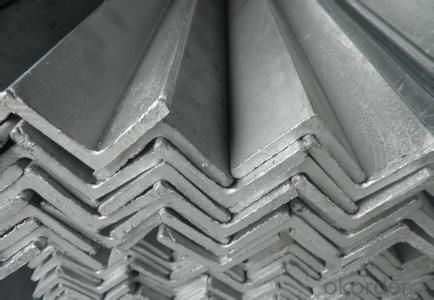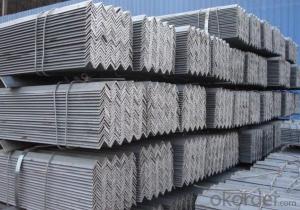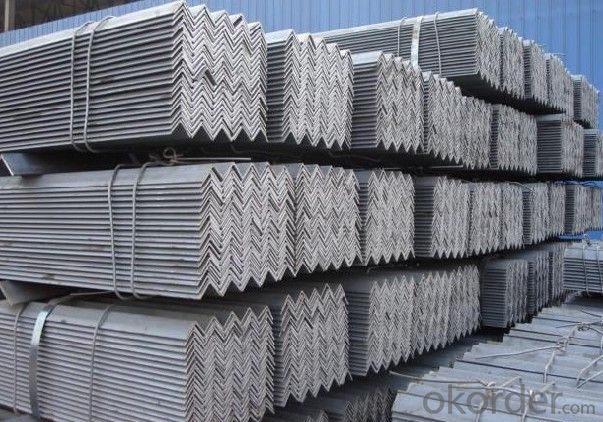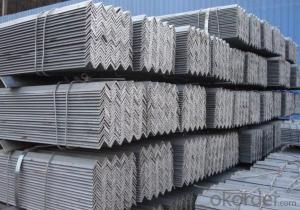Steel Equal Angle And Unequal Angle Steel
- Loading Port:
- Tianjin
- Payment Terms:
- TT OR LC
- Min Order Qty:
- 25 m.t.
- Supply Capability:
- 20000000 m.t./month
OKorder Service Pledge
OKorder Financial Service
You Might Also Like
Specification
Product Description:
OKorder is offering Steel Equal Angle And Unequal Angle Steel at great prices with worldwide shipping. Our supplier is a world-class manufacturer of steel, with our products utilized the world over. OKorder annually supplies products to European, North American and Asian markets. We provide quotations within 24 hours of receiving an inquiry and guarantee competitive prices.
Product Applications:
According to the needs of different structures, Angle can compose to different force support component, and also can be the connections between components. It is widely used in various building structures and engineering structures such as roof beams, bridges, transmission towers, hoisting machinery and transport machinery, ships, industrial furnaces, reaction tower, container frame and warehouse etc
Product Advantages:
OKorder's Steel Steel Equal Angle And Unequal Angle Steel are durable, strong, and resist corrosion.
Main Product Features:
· Premium quality
· Prompt delivery & seaworthy packing (30 days after receiving deposit)
· Corrosion resistance
· Can be recycled and reused
· Mill test certification
· Professional Service
· Competitive pricing
Product Specifications:
Manufacture: Hot rolled
Grade: Q195 – 235
Certificates: ISO, SGS, BV, CIQ
Length: 6m – 12m, as per customer request
Packaging: Export packing, nude packing, bundled
Sizes: 25mm-250mm | ||||||||||||
a*t | ||||||||||||
25*2.5-4.0 | 70*6.0-9.0 | 130*9.0-15 | ||||||||||
30*2.5-6.6 | 75*6.0-9.0 | 140*10-14 | ||||||||||
36*3.0-5.0 | 80*5.0-10 | 150*10-20 | ||||||||||
38*2.3-6.0 | 90*7.0-10 | 160*10-16 | ||||||||||
40*3.0-5.0 | 100*6.0-12 | 175*12-15 | ||||||||||
45*4.0-6.0 | 110*8.0-10 | 180*12-18 | ||||||||||
50*4.0-6.0 | 120*6.0-15 | 200*14-25 | ||||||||||
60*4.0-8.0 | 125*8.0-14 | 250*25 | ||||||||||
FAQ:
Q1: How soon can we receive the product after purchase?
A1: Within three days of placing an order, we will begin production. The specific shipping date is dependent upon international and government factors, but is typically 7 to 10 workdays.
Q2: What makes stainless steel stainless?
A2: Stainless steel must contain at least 10.5 % chromium. It is this element that reacts with the oxygen in the air to form a complex chrome-oxide surface layer that is invisible but strong enough to prevent further oxygen from "staining" (rusting) the surface. Higher levels of chromium and the addition of other alloying elements such as nickel and molybdenum enhance this surface layer and improve the corrosion resistance of the stainless material.
Q3: Can stainless steel rust?
A3: Stainless does not "rust" as you think of regular steel rusting with a red oxide on the surface that flakes off. If you see red rust it is probably due to some iron particles that have contaminated the surface of the stainless steel and it is these iron particles that are rusting. Look at the source of the rusting and see if you can remove it from the surface.
Q2: How do you package the angle steel when shipping?
A2: All goods are packed in bundles with steel strips and shipped by container or break bulk.
Q3: The products are invoicing on theoritical weight or on actual weight?
A3: We can do it in both manners, according to the customers' request.


- Q: Can steel angles be used for reinforcing concrete structures?
- Yes, steel angles can be used for reinforcing concrete structures. Steel angles provide additional strength and stability to concrete structures, increasing their load-bearing capacity and resistance to bending and shearing forces. These angles are typically used to reinforce corners, edges, and joints, helping to prevent cracking and enhance the overall durability of the structure.
- Q: Can steel angles be used in sports facilities or stadium constructions?
- Yes, steel angles can be used in sports facilities or stadium constructions. Steel angles are commonly used in construction projects due to their strength and durability. They can be used to provide support and stability in various structural elements, such as beams, columns, and frames, making them suitable for use in sports facilities or stadium constructions where robustness and reliability are crucial.
- Q: How does the weight of a steel angle affect its load-bearing capacity?
- The weight of a steel angle directly affects its load-bearing capacity. In general, a heavier steel angle has a higher load-bearing capacity compared to a lighter one. This is because the weight of the angle contributes to its overall strength and stability. When a load is applied to a steel angle, it creates both compressive and tensile forces within the material. The weight of the angle helps to distribute these forces evenly, minimizing the risk of deformation or failure. Additionally, a heavier steel angle typically indicates a higher density and a greater amount of material used in its construction. This means that the angle can withstand larger loads without undergoing significant deflection or structural damage. It is important to note that the load-bearing capacity of a steel angle is also influenced by other factors such as its dimensions, material properties, and the type of connection used. However, the weight of the angle remains a crucial consideration in determining its overall strength and ability to support loads.
- Q: Can steel angles be used for manufacturing equipment frames?
- Indeed, the utilization of steel angles in the fabrication of equipment frames is possible. Their strength, durability, and versatility render steel angles frequently employed in construction and manufacturing fields. By providing structural support and stability, they prove to be an optimal choice for the design and construction of equipment frames. The ease with which steel angles can be welded or bolted together enables the creation of rigid and robust frame structures. Moreover, their ability to be cut into specific lengths and shapes allows for precise assembly and customization. In conclusion, the reliability and cost-effectiveness of steel angles make them a favored selection for the manufacturing of equipment frames.
- Q: What is the maximum allowable compressive stress for a steel angle?
- The maximum allowable compressive stress for a steel angle depends on various factors such as the grade of steel, the dimensions and geometry of the angle, and the specific application or industry standards. Generally, steel angles are designed to withstand compressive loads, which push or squeeze the material together. To determine the maximum allowable compressive stress for a steel angle, it is essential to refer to structural design codes and standards, such as the American Institute of Steel Construction (AISC) Manual or Eurocode. These standards provide guidelines and formulas for calculating the maximum allowable compressive stress based on the steel grade and the cross-sectional properties of the angle. For instance, the AISC Manual provides a formula to calculate the nominal compressive strength of a steel angle based on its slenderness ratio. The slenderness ratio is the ratio of the length of the angle to its radius of gyration, which measures how slender or compact the angle is. The formula takes into account the yield strength of the steel and the slenderness ratio to determine the maximum compressive stress the angle can sustain without buckling. It is important to note that the maximum allowable compressive stress should not exceed the yield strength of the steel angle. The yield strength is the point at which the material begins to deform permanently, and exceeding this limit can lead to structural failure. Therefore, to accurately determine the maximum allowable compressive stress for a steel angle, it is recommended to consult relevant design codes and standards, or consult with a structural engineer who can assess the specific application and provide a precise answer based on the pertinent factors.
- Q: How do steel angles perform in high-temperature environments?
- The inherent properties of steel angles make them highly effective in high-temperature environments. Steel is renowned for its ability to withstand elevated temperatures without significant structural degradation, thanks to its high melting point and thermal conductivity. This means that steel angles maintain their strength and stability, making them suitable for a wide range of applications. A key factor contributing to the exceptional performance of steel angles in high-temperature environments is their structural integrity. Steel has a high melting point, typically between 1300 and 1500 degrees Celsius, depending on the specific grade. This ensures that steel angles retain their shape even in extreme heat conditions, providing durability and reliability. Furthermore, steel's low coefficient of thermal expansion minimizes expansion and contraction when exposed to temperature changes. This is crucial in high-temperature environments as it reduces the risk of warping or distortion of steel angles. The dimensional stability of steel angles enables them to withstand thermal cycling without compromising their structural strength. Moreover, steel exhibits excellent thermal conductivity, enabling efficient heat dissipation. This prevents the accumulation of excessive heat in steel angles, reducing the risk of thermal stress or failure. By effectively transferring heat away from critical components, steel angles increase their durability and longevity in high-temperature environments. Additionally, steel angles can be further enhanced with heat-resistant coatings or treatments. These coatings provide an extra layer of protection against oxidation, corrosion, and thermal degradation, enhancing the resilience of steel angles in extreme heat conditions. To summarize, steel angles are an ideal choice for high-temperature environments due to their high melting point, low thermal expansion, excellent thermal conductivity, and the possibility of additional heat-resistant coatings. Their ability to maintain structural integrity, dimensional stability, and efficient heat dissipation makes them a reliable solution for various applications where exposure to elevated temperatures is a concern.
- Q: What are the common shapes and dimensions of steel angles?
- The common shapes of steel angles include equal angles, unequal angles, and L-shaped angles. The dimensions of these angles can vary widely, but some common sizes include 1/2 inch, 3/4 inch, 1 inch, 1-1/2 inch, and 2 inches. The thickness or gauge of the angles can also differ, typically ranging from 1/8 inch to 1/4 inch.
- Q: How do steel angles perform in chemical industry applications?
- Steel angles are widely used in chemical industry applications due to their excellent performance in corrosive environments. These angles, made of high-strength steel, exhibit exceptional resistance to chemicals, acids, and other corrosive substances commonly found in the chemical industry. The chemical industry often involves the handling and processing of various chemicals, which can lead to corrosion and degradation of structural materials. Steel angles, with their high corrosion resistance, provide a reliable and durable solution in such environments. Moreover, steel angles offer excellent load-bearing capacity and structural stability, making them ideal for supporting heavy equipment, tanks, and platforms in chemical plants. Their versatility allows for the construction of various structures and equipment, ensuring the safe and efficient operation of chemical processes. Steel angles can be fabricated into different sizes and shapes, allowing for easy customization to meet specific requirements. This versatility makes them suitable for a wide range of applications such as piping systems, storage tanks, chemical reactors, and support structures. In addition to their corrosion resistance and structural strength, steel angles are also cost-effective. They have a long lifespan, require minimal maintenance, and can withstand extreme temperatures, pressures, and chemical exposures. This durability and low maintenance requirement contribute to reducing downtime and overall operating costs in the chemical industry. Overall, steel angles perform exceptionally well in chemical industry applications by providing a combination of corrosion resistance, structural strength, versatility, and cost-effectiveness. Their ability to withstand harsh chemical environments makes them an essential component in the safe and efficient operation of chemical processes.
- Q: How do you calculate the shear strength of a steel angle?
- To calculate the shear strength of a steel angle, you need to determine the area of the cross-section multiplied by the shear stress limit of the material. The shear stress limit can be obtained from the material's specifications or testing.
- Q: How are steel angles protected against abrasion?
- Steel angles find common applications in construction and industrial settings, where they are exposed to various forms of abrasion. To safeguard steel angles against abrasion, multiple techniques are employed. One prevalent approach involves the use of protective coatings, such as paints, epoxy coatings, or specialized coatings designed for abrasion resistance. These coatings act as a barrier between the steel surface and abrasive elements, preventing direct contact and minimizing wear caused by friction. Another method entails the application of rubber or plastic linings to the susceptible surfaces of steel angles. These linings absorb the impact of abrasive forces, cushioning the steel and reducing wear. Additionally, they provide an extra layer of protection against corrosion and chemical attacks. In certain cases, steel angles may undergo hardening or heat treatment. This process involves subjecting the steel to high temperatures followed by rapid cooling, altering the steel's microstructure to enhance hardness and resistance to abrasion. Heat-treated steel angles are commonly used in industries with high-wear environments, such as mining and material handling. Furthermore, engineers may choose to design steel angles with specific profiles or shapes that offer improved resistance to abrasion. These profiles may include rounded edges, chamfers, or other features that minimize direct contact with abrasive materials. Overall, protecting steel angles from abrasion involves a combination of protective coatings, linings, heat treatment, and thoughtful design. Implementing these measures significantly prolongs the lifespan and performance of steel angles, reducing maintenance costs and ensuring durability in abrasive environments.
Send your message to us
Steel Equal Angle And Unequal Angle Steel
- Loading Port:
- Tianjin
- Payment Terms:
- TT OR LC
- Min Order Qty:
- 25 m.t.
- Supply Capability:
- 20000000 m.t./month
OKorder Service Pledge
OKorder Financial Service
Similar products
Hot products
Hot Searches
Related keywords



























